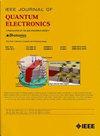Polarization-Maintaining Fiber With Uniform Doping Concentration Supporting 10 Weakly Coupled Modes Designed by Swarm Intelligence
IF 2.1
3区 工程技术
Q3 ENGINEERING, ELECTRICAL & ELECTRONIC
引用次数: 0
Abstract
In this study, we propose a polarization-maintaining few-mode fiber (PM-FMF) with a uniform doping concentration, capable of supporting up to 10 weakly coupled modes. The fiber features a simple structure with a perforated core, designed using a particle swarm optimization (PSO) algorithm. The proposed design achieves a minimum effective refractive index difference (采用群智能设计的支持10种弱耦合模式的均匀掺杂浓度保偏光纤
在这项研究中,我们提出了一种具有均匀掺杂浓度的保偏少模光纤(PM-FMF),能够支持多达10个弱耦合模式。该纤维结构简单,芯部穿孔,采用粒子群优化算法设计。所提出的设计在1550 nm处实现了最小有效折射率差($\Delta n_{\text {eff}}$)约$3.819 \乘以10^{-4}$,确保了良好的模式隔离。此外,该结构具有强大的抗弯性能,并优化了关键参数以减轻模式耦合和约束损失。误差分析揭示了光纤对制造缺陷的容忍度,包括纤芯尺寸、折射率和气孔位移。这种设计对于大容量、短距离光通信系统(如数据中心)具有巨大的潜力。这一发现为设计低复杂度和高性能的下一代光纤提供了有价值的见解。
本文章由计算机程序翻译,如有差异,请以英文原文为准。
求助全文
约1分钟内获得全文
求助全文
来源期刊

IEEE Journal of Quantum Electronics
工程技术-工程:电子与电气
CiteScore
4.70
自引率
4.00%
发文量
99
审稿时长
3.0 months
期刊介绍:
The IEEE Journal of Quantum Electronics is dedicated to the publication of manuscripts reporting novel experimental or theoretical results in the broad field of the science and technology of quantum electronics. The Journal comprises original contributions, both regular papers and letters, describing significant advances in the understanding of quantum electronics phenomena or the demonstration of new devices, systems, or applications. Manuscripts reporting new developments in systems and applications must emphasize quantum electronics principles or devices. The scope of JQE encompasses the generation, propagation, detection, and application of coherent electromagnetic radiation having wavelengths below one millimeter (i.e., in the submillimeter, infrared, visible, ultraviolet, etc., regions). Whether the focus of a manuscript is a quantum-electronic device or phenomenon, the critical factor in the editorial review of a manuscript is the potential impact of the results presented on continuing research in the field or on advancing the technological base of quantum electronics.
 求助内容:
求助内容: 应助结果提醒方式:
应助结果提醒方式:


